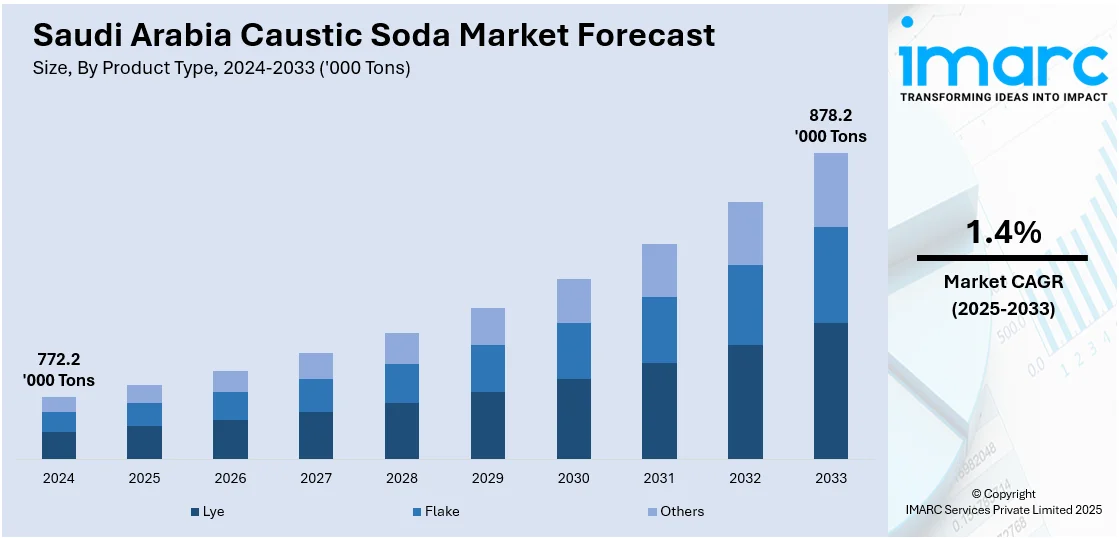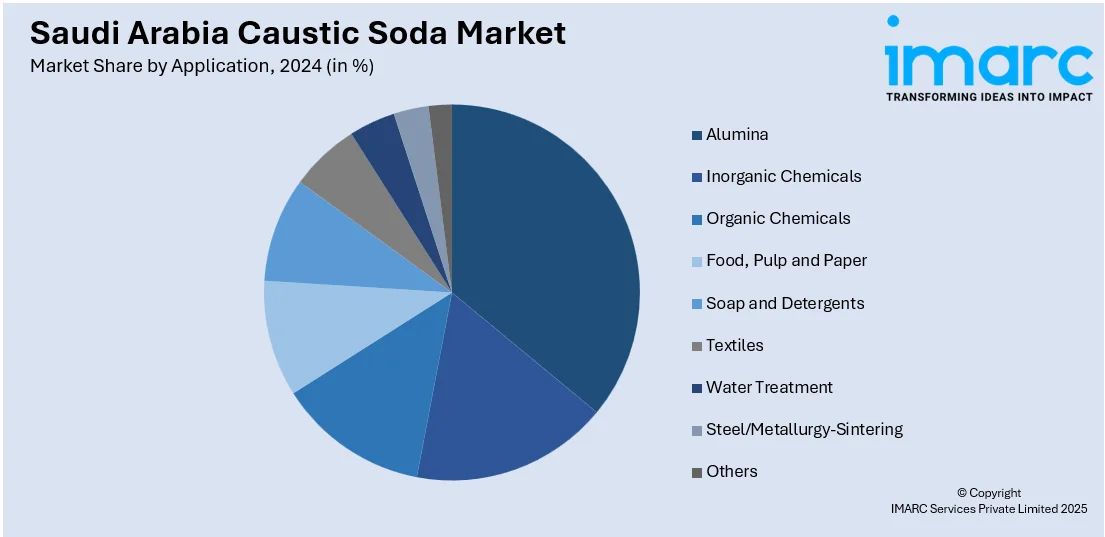
Saudi Arabia Caustic Soda Market Size, Share, Trends and Forecast by Product Type, Manufacturing Process, Grade, Application, and Region, 2025-2033
Saudi Arabia Caustic Soda Market Overview:
The Saudi Arabia caustic soda market size reached 772.2 Thousand Tons in 2024. Looking forward, IMARC Group expects the market to reach 878.2 Thousand Tons by 2033, exhibiting a growth rate (CAGR) of 1.4% during 2025-2033. The growing demand from industries like chemicals, textiles, and paper, increasing investments in petrochemical sectors, government initiatives to diversify the economy, and the rising need for water treatment and manufacturing applications are some of the factors propelling the growth of the market.
|
Report Attribute
|
Key Statistics
|
|---|---|
|
Base Year
|
2024 |
|
Forecast Years
|
2025-2033
|
|
Historical Years
|
2019-2024
|
| Market Size in 2024 | 772.2 Thousand Tons |
| Market Forecast in 2033 | 878.2 Thousand Tons |
| Market Growth Rate 2025-2033 | 1.4% |
Saudi Arabia Caustic Soda Market Trends:
Economic Expansion in the Chemical Sector
Saudi Arabia's chemical industry is witnessing high growth, spurred by increasing demand from sectors like aluminum, textiles, and chemicals. The government's economic diversification strategy, aligned with Vision 2030, is promoting heightened investments in the main industries. High-level agreements valued at billions of riyals will enhance the production capacity and improve the competitive standing of the Kingdom in the world. With increasing industrial needs, this growth is likely to underpin Saudi Arabia's long-term economic ambitions, lowering dependency on oil and raising its status in global markets. The shift emphasizes the Kingdom's aspiration to be a central player in the international chemical sector. For example, in November 2023, at the Jazan Investment Forum, agreements worth SAR 32 Billion were signed, highlighting significant growth in Saudi Arabia’s caustic soda market. With rising demand from key industries like aluminum and textiles, the market is set for substantial expansion. This move aligns with Saudi Vision 2030, which aims to diversify the economy and reduce oil dependency. The increased investments are expected to strengthen the Kingdom’s position in the global caustic soda sector.

Enhancing Chemical Manufacturing Capabilities
Saudi Arabia is making significant strides in developing key infrastructure to enhance its chemical production capabilities, particularly in caustic soda. This initiative aligns with the Kingdom’s broader efforts to diversify its economy and reduce oil dependency. The infrastructure upgrades are expected to substantially increase production capacity, opening new export opportunities and supporting domestic industrial growth. These developments position Saudi Arabia to become a major player in the global chemical sector, boosting its competitive edge and creating long-term economic benefits. This move highlights the country’s commitment to advancing its manufacturing sector as part of its Vision 2030 goals. For instance, in November 2024, TA'ZIZ awarded over USD 2 Billion in contracts to boost industrial growth in Saudi Arabia for the development of key infrastructure to enhance the production of chemicals, including caustic soda. The initiative aligns with Saudi Arabia's efforts to strengthen its chemical manufacturing capabilities and diversify its economy. These infrastructure upgrades are expected to significantly support the caustic soda market, driving production capacity and export opportunities.
Saudi Arabia Caustic Soda Market Segmentation:
IMARC Group provides an analysis of the key trends in each segment of the market, along with forecasts at the region/country level for 2025-2033. Our report has categorized the market based on product type, manufacturing process, grade, and application.
Product Type Insights:
- Lye
- Flake
- Others
The report has provided a detailed breakup and analysis of the market based on the product type. This includes lye, flake, and others.
Manufacturing Process Insights:
- Membrane Cell
- Diaphragm Cell
- Others
A detailed breakup and analysis of the market based on the manufacturing process have also been provided in the report. This includes membrane cell, diaphragm cell, and others.
Grade Insights:
- Reagent Grade
- Industrial Grade
- Pharmaceutical Grade
- Others
The report has provided a detailed breakup and analysis of the market based on the grade. This includes reagent grade, industrial grade, pharmaceutical grade, and others.
Application Insights:

- Alumina
- Inorganic Chemicals
- Organic Chemicals
- Food, Pulp and Paper
- Soap and Detergents
- Textiles
- Water Treatment
- Steel/Metallurgy-Sintering
- Others
A detailed breakup and analysis of the market based on the application have also been provided in the report. This includes alumina, inorganic chemicals, organic chemicals, food pulp and paper, soap and detergents, textiles, water treatment, steel/metallurgy-sintering, and others.
Regional Insights:
- Northern and Central Region
- Western Region
- Eastern Region
- Southern Region
The report has also provided a comprehensive analysis of all the major regional markets, which include Northern and Central Region, Western Region, Eastern Region, and Southern Region.
Competitive Landscape:
The market research report has also provided a comprehensive analysis of the competitive landscape. Competitive analysis such as market structure, key player positioning, top winning strategies, competitive dashboard, and company evaluation quadrant has been covered in the report. Also, detailed profiles of all major companies have been provided.
Saudi Arabia Caustic Soda Market News:
- In February 2025, ThyssenKrupp secured a contract with Saudi Arabia's Basic Chemical Industries (BCI) for the expansion of its chlor-alkali plant in Jubail. The project aims to boost the plant's caustic soda and chlorine production. With an investment of SAR 89 Million, the expansion would increase revenue and operating profit, strengthening Saudi Arabia’s chemical manufacturing sector. Completion is set for 19 months, reinforcing BCI’s market position in the region.
Saudi Arabia Caustic Soda Market Report Coverage:
| Report Features | Details |
|---|---|
| Base Year of the Analysis | 2024 |
| Historical Period | 2019-2024 |
| Forecast Period | 2025-2033 |
| Units | Thousand Tons |
| Scope of the Report |
Exploration of Historical Trends and Market Outlook, Industry Catalysts and Challenges, Segment-Wise Historical and Future Market Assessment:
|
| Product Types Covered | Lye, Flake, Others |
| Manufacturing Processes Covered | Membrane Cell, Diaphragm Cell, Others |
| Grades Covered | Reagent Grade, Industrial Grade, Pharmaceutical Grade, Others |
| Applications Covered | Alumina, Inorganic Chemicals, Organic Chemicals, Food Pulp and Paper, Soap and Detergents, Textiles, Water Treatment, Steel/Metallurgy-Sintering, Others |
| Regions Covered | Northern and Central Region, Western Region, Eastern Region, Southern Region |
| Customization Scope | 10% Free Customization |
| Post-Sale Analyst Support | 10-12 Weeks |
| Delivery Format | PDF and Excel through Email (We can also provide the editable version of the report in PPT/Word format on special request) |
Key Questions Answered in This Report:
- How has the Saudi Arabia caustic soda market performed so far and how will it perform in the coming years?
- What is the breakup of the Saudi Arabia caustic soda market on the basis of product type?
- What is the breakup of the Saudi Arabia caustic soda market on the basis of manufacturing process?
- What is the breakup of the Saudi Arabia caustic soda market on the basis of grade?
- What is the breakup of the Saudi Arabia caustic soda market on the basis of application?
- What are the various stages in the value chain of the Saudi Arabia caustic soda market?
- What are the key driving factors and challenges in the Saudi Arabia caustic soda market?
- What is the structure of the Saudi Arabia caustic soda market and who are the key players?
- What is the degree of competition in the Saudi Arabia caustic soda market?
Key Benefits for Stakeholders:
- IMARC’s industry report offers a comprehensive quantitative analysis of various market segments, historical and current market trends, market forecasts, and dynamics of the Saudi Arabia caustic soda market from 2019-2033.
- The research report provides the latest information on the market drivers, challenges, and opportunities in the Saudi Arabia caustic soda market.
- Porter's five forces analysis assist stakeholders in assessing the impact of new entrants, competitive rivalry, supplier power, buyer power, and the threat of substitution. It helps stakeholders to analyze the level of competition within the Saudi Arabia caustic soda industry and its attractiveness.
- Competitive landscape allows stakeholders to understand their competitive environment and provides an insight into the current positions of key players in the market.
Need more help?
- Speak to our experienced analysts for insights on the current market scenarios.
- Include additional segments and countries to customize the report as per your requirement.
- Gain an unparalleled competitive advantage in your domain by understanding how to utilize the report and positively impacting your operations and revenue.
- For further assistance, please connect with our analysts.
 Request Customization
Request Customization
 Speak to an Analyst
Speak to an Analyst
 Request Brochure
Request Brochure
 Inquire Before Buying
Inquire Before Buying




.webp)




.webp)












